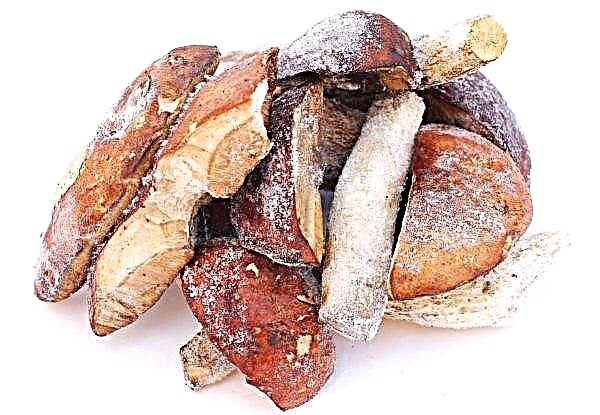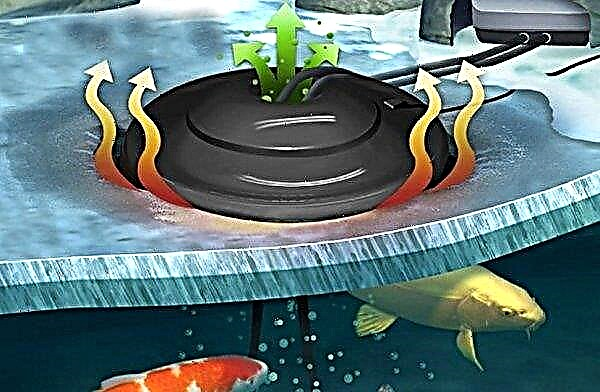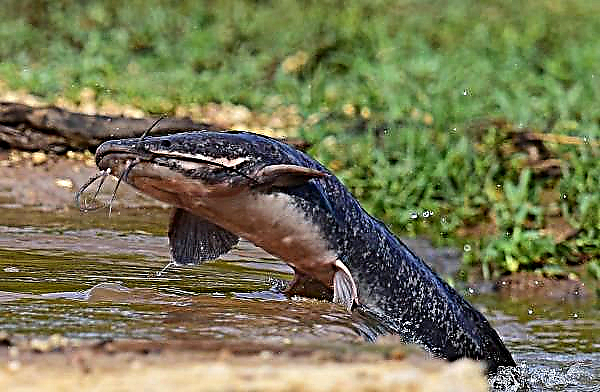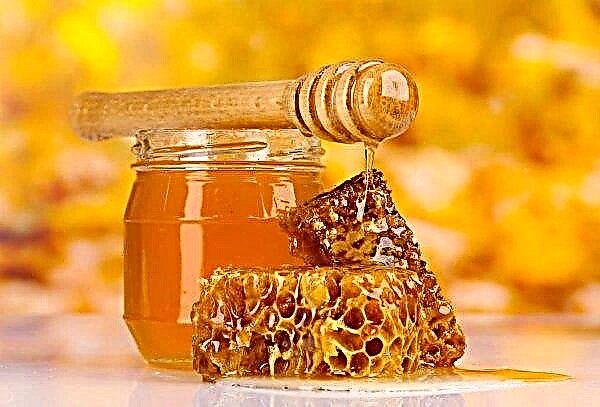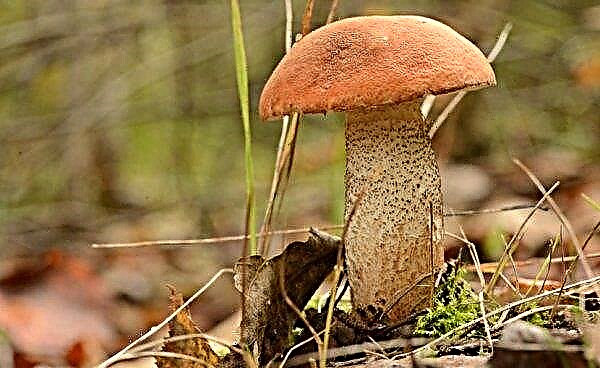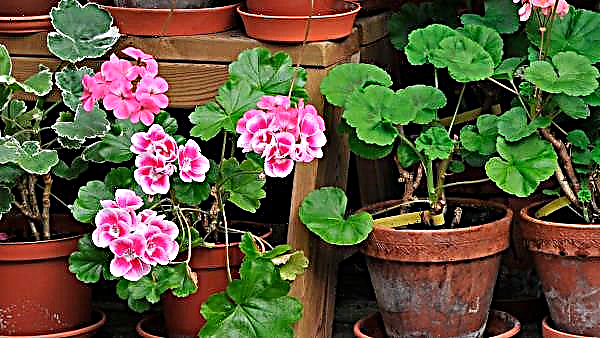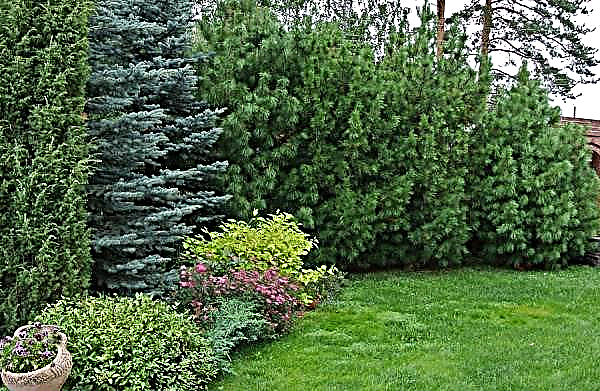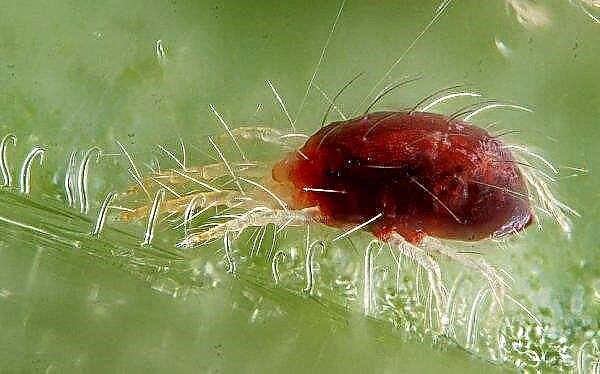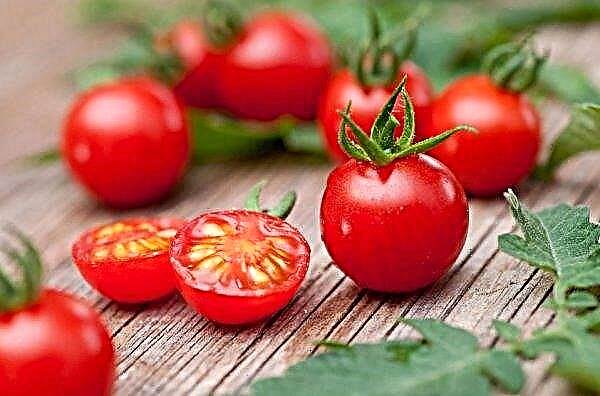Each lover of delicious tomatoes and a gardener who grows them on his site has his own specific varieties, which they prefer. Some like small red tomatoes with a sweet and sour taste, while others like yellowish larger fruits with crumbly flesh. But many love to feast on real pink giants with pulp, which has a sweet taste and juiciness. These include the Pink Honey tomatoes, which will be discussed in the article.
Description and characteristics of the variety
This variety was bred in 2005 by breeders and entrepreneurs from Novosibirsk, O. Postnikova and V. Dederko. At the end of 2006, it was included in the State Register of Russia, patented. The variety is recommended for cultivation both in open space and in greenhouse conditions throughout the country.
Did you know? At least 10 thousand different varieties of tomatoes are known.
"Pink Honey" is characterized by a number of features:
- it is a variety with medium ripening times;
- its bushes are semi-determinant;
- in each hand, from three to ten ovaries form;
- Tomatoes ripen in the period from 111 to 115 days;
- begin to bear fruit in August;
- the yield of one plant is up to 6 kilograms;
- when grown in open areas, they reach a height of 0.7 meters; in greenhouse conditions, their height can be 1.5 meters;
- the first specimens that appear on the bushes can weigh up to 1.5 kilograms;
- further fruits weigh from 0.6 to 0.8 kg;
- tomatoes are pink in color;
- characterized by a sweet, sour-free taste of juicy pulp;
- chambers in tomatoes from four or more;
- the fruits are distinguished by a shape resembling a heart, and some ribbing;
- the skin of tomatoes is thin;
- used for the preparation of salads, juice, ketchups, sauces and a number of other preparations;
- due to the thin skin and considerable size, they are not used for whole marinating.

Advantages and disadvantages
- Tomatoes “Pink Honey” have a number of positive characteristics that can turn everyone who grew and consumed them into a real admirer of this variety:
- attractive appearance;
- the fruits are distinguished by excellent taste;
- Tomatoes make tasty salads, preserves (juices, sauces, mashed potatoes, ketchups and more);
- the variety is not crossed, which makes it possible to collect seeds in the required quantity, and this saves money, since the seeds need to be purchased only once;
- suitable for planting both in greenhouses and in open spaces;
- from one plant you can collect up to 6 kilograms of fruit;
- plants are resistant to drought.
- Those gardeners who planted “Pink Honey” point out some shortcomings:
- thin skin and large sizes make it impossible to preserve or grease whole tomatoes;
- collected tomatoes are stored for a relatively short time and can hardly be transported without damage;
- the fruits crack;
- plants require indispensable garter and removal of stepsons;
- the variety is not hybrid, which makes it not resistant to harmful microorganisms and insects, the appearance of which is characteristic of all tomatoes;
- requires constant preventive measures to eliminate the threat of infections and pests.
Features of growing varieties
As for other tomatoes, “Pink Honey” is characterized by some features of the cultivation, in which it is quite possible to get the maximum volume of the crop.
Optimal conditions
“Pink Honey” prefers average temperature standards: in the range from +10 to +15 ° С, the process of plant development begins to stop, tomatoes also feel unwell and at high temperatures from +30 ° С. An important factor for the full development of tomatoes is the availability of good lighting, without which it is not worth waiting for a harmonious development of plants and obtaining a plentiful harvest. With a lack of light, plants begin to wither.
An important factor for the full development of tomatoes is the availability of good lighting, without which it is not worth waiting for a harmonious development of plants and obtaining a plentiful harvest. With a lack of light, plants begin to wither.
Most harmoniously, “Pink Honey” develops in conditions of moderate humidity.Important! But the rays of the scorching sun are strictly contraindicated in tomato bushes.
Features of sowing seeds
Seeds are sown in the soil from the end of winter to the beginning of spring. Before sowing, you should prepare the seeds themselves, the container and the soil in which they will be placed.
Since the variety “Pink Honey” is not hybrid, not only purchased seeds are suitable, but also collected from last year's crop, from which the same large and high-quality tomatoes should appear as from the mother ones.
To do this, the pulp of a tomato with seeds is kneaded and after three days it is washed with running water through a sieve. Seeds are dried in the fresh air by folding on a paper sheet.
Important! To get the seeds you need to take more large and ripe fruit.
The resulting seed is soaked in saline to determine unsuitable (those that have surfaced) specimens. Next, the seeds undergo a disinfection treatment in a weak solution of potassium permanganate, after which they are washed with water and dried.
Different containers (wooden, plastic, plastic) are suitable for planting seeds for seedlings, but best of all are special containers with lids in which a greenhouse effect can be created. Tanks previously will not be amiss to process with boiling water or a solution of potassium permanganate. The soil mixture is prepared from turf land, peat, sand, mineral and organic fertilizers or used purchased. Before disembarking, it should be disinfected in the oven or pour it with a solution of potassium permanganate.
The soil mixture is prepared from turf land, peat, sand, mineral and organic fertilizers or used purchased. Before disembarking, it should be disinfected in the oven or pour it with a solution of potassium permanganate.
Seeds are sown to a depth of 1 to 2 centimeters. Watering is carried out using a spray. Containers should be covered with a lid, film or glass for faster germination of seeds. The containers should be located in a warm and dry place.
The first sprouts begin to be observed after about 7 days. Moderate watering should be carried out and condensation formed should be removed from the cover.
Did you know? In a state of depression, eating tomatoes leads to better moods.
Seedling Care
After the plants form the first few leaves, which occurs up to two weeks after emergence, they need to be dived. At the same time, plants are transplanted into boxes filled with nutrient soil, at a distance of 10 centimeters from each other, each deepening to cotyledon leaves.
After a fortnight, the plants again dive into separate containers with a drainage layer. The volume of each tank should be up to one liter, peat humus cups can come in handy here.
Before transplanting into permanent soil, seedlings should be fertilized with complex mineral and vitamin fertilizing twice.
It is also necessary to adapt the seedlings one and a half to two weeks before planting it at a permanent place of cultivation. For this, the seedlings are first taken out for several hours in a glazed room (balcony, veranda), and then to fresh air. Each time, such manipulations should increase in time.
Planting seedlings in the ground
The timing of planting Pink Honey tomatoes at a permanent place of cultivation largely depends on the climate of the area and where they will grow: plants are planted in greenhouses in April, without heating in May, and in open soil in June. When planting, tomato seedlings should be no higher than 30 centimeters.
Important! With a high stem, seedlings can be planted in a horizontal position, placing a root in the pit along with two-thirds of the stem, laying the plant in the direction to the south and sprinkling with a 10-centimeter layer of soil.
Planting should occur according to the scheme of 50x40 centimeters at the rate of 3 bushes per 1 square meter of area. The soil is pre-fed with mineral and organic fertilizers, it is advisable to disinfect it with a potassium permanganate solution. After planting, plants need to water, pritenit.
It is necessary to try to avoid planting tomato seedlings from year to year in the same place, as soil depletion, a decrease in the level of nutrient components, and accumulation of sources of diseases and pests occur.
In order not to provoke the occurrence of diseases in tomatoes, when planting their seedlings, special attention should also be paid to what kind of plants they had predecessors.
How to care for tomatoes
Tomatoes "Pink Honey" require standard care, but keep in mind that this variety is not hybrid, therefore it is not resistant to negative environmental factors, harmful bacteria and insects.
Important! The soil after beans, garlic, radish, carrots, cabbage is best suited for growing tomatoes, but in no case should you plant tomatoes in the territory where last year potatoes, eggplant, bell pepper were grown.
Feeding and watering
Fertilizing pink honey tomatoes helps to increase the number of fruits and their taste characteristics.
Fertilize tomatoes several times:
- 2 weeks after transplanting seedlings into the ground;
- before the plant blooms;
- when ovaries begin to form;
- during fruit ripening.
 Various types of fertilizers are suitable for the tomatoes in question:
Various types of fertilizers are suitable for the tomatoes in question:- Phosphorus Feeding support harmonious root development. It is necessary to make an aqueous solution of superphosphate and water the bushes.
- Potash contribute to improving the taste characteristics of tomatoes and strengthening their protective functions.
- Integrated - Specially developed mineral and vitamin formulations.
- Combined Mineral Refillapplied during the growth period. It is prepared from 5 g of ammonium nitrate, 15 g of potassium chloride, 30 g of superphosphate, diluted in 10 liters of water. The mixture is added only at the root.
- Ash - universal recharge, for which it is necessary to dilute 1 glass of powdered ash in 10 liters of water.
- Boron solution effective during flowering. To obtain it, 1 gram of the active substance is added to 1 liter of water, the tomato leaves are treated with the resulting mixture.
- Organic fertilizer based on chicken droppings or manure (organics are diluted in water in a proportion of 1:10).
Tomatoes “Pink Honey” do not require abundant watering, in which plants are more easily affected by fungi, damage and premature fall of their leaves and fruits occur. After planting tomatoes at a permanent place of cultivation, they are watered as follows: the next watering is needed only after a week and a half, then about twice a week. As fruiting, water volumes for irrigation decrease. For large tomato plantations, drip irrigation is ideal.
After planting tomatoes at a permanent place of cultivation, they are watered as follows: the next watering is needed only after a week and a half, then about twice a week. As fruiting, water volumes for irrigation decrease. For large tomato plantations, drip irrigation is ideal.
Watering tomatoes is recommended in the morning and evening after sunset. The water temperature should be at least 20 ° C. When watering, to avoid burns to the leaves, make sure that water does not get on them.
Important! "Pink honey" is one of those varieties that do not like moisture, it is recommended to water them when the soil has completely dried in depth by a couple of centimeters. When abundantly watered during hot and dry periods, the fruits may crack.
Pasynkovka and formation of a bush
Pink Honey Tomatoes need to be planted and bushes formed. With the uncontrolled growth of these tomatoes, they can grow, resembling real thickets.
First you need to remove the stepsons under the brush of flowers - they should not be longer than 5 centimeters. Stepson better in the morning in dry warm weather. This should be done manually at intervals of one and a half weeks.
To form tomatoes "Pink Honey" is recommended in two stems.
In order to properly form tomato bushes, you need to conduct the first stepsoning together with tying the bushes before the first flowers appear. Stems need to be tied to a peg driven into the ground - tied bushes are more resistant to bad weather.
Protection against diseases and pests
Tomatoes of the “Pink Honey” variety are not particularly resistant to diseases and pests, but with a competent approach, you can avoid such unpleasant moments or eliminate them in time. And then late blight, brown spotting, gray rot, apical rot, scoop, Colorado potato beetle, aphids will necessarily recede.
Did you know? Tomatoes effectively cope with a hangover, neutralizing the effect of alcohol on the human body.
For the purpose of preventive measures, it is recommended:
- water the plants without droplets on the leaves;
- plant tomatoes away from potatoes;
- periodically treat leaves with Bordeaux liquid;
- to treat bushes with fungicides.
If the prevention was carried out insufficiently or untimely and it was not possible to avoid the appearance of infectious diseases or pests, then you must immediately take measures to eliminate the negative phenomena:
- infected leaves and stems must be removed and burned;
- carry out treatment with fungicidal preparations (for example, Ridomil) at the doses indicated in the instructions for the treatment of tomatoes;
- you can treat the bushes and the soil around them with folk remedies (a solution of garlic, whey, manganese, soda, ash, onion, iodine, boric acid and other components).

Harvesting and storage
Bushes of "Pink Honey" most often give the impression of some weakness due to their high growth and a small number of leaves. But, despite this, they are able to bring quite abundant yields from each plant, up to 6 kilograms. You can collect fruits from August until the end of fruiting.
Important! At the end of the season, you need to remove all plants from the garden, dig the ground, replacing the place for planting tomatoes for the next year.
Since these tomatoes require a rather delicate relationship due to their thin skin and large size, they must be collected carefully by placing them in boxes, preferably in one layer.
Keeping tomatoes for a long time will not work, so immediately after harvesting, they are best used for their intended purpose.
Grade Application
If you want to use fresh pink honey tomatoes, it’s best to do it right away. Tomatoes have a great taste. They are an excellent component of any salad. They also make excellent preparations: sauces, ketchups, juices, pastes and many other dishes, which include tomatoes. Since the thin peel begins to crack under the influence of boiling water, then it is not possible to preserve them whole; moreover, not every fruit will fit in a jar.
Since the thin peel begins to crack under the influence of boiling water, then it is not possible to preserve them whole; moreover, not every fruit will fit in a jar.
Each gardener decides which tomato variety to choose, however, if you focus on the “Pink Honey” variety, you can be completely satisfied with the choice made.
These plants withstand tolerance of dry periods, give abundant and tasty harvests - for the sake of such results it is not at all difficult to give them a little more attention when combating harmful microorganisms and insects, tying and pinching.

